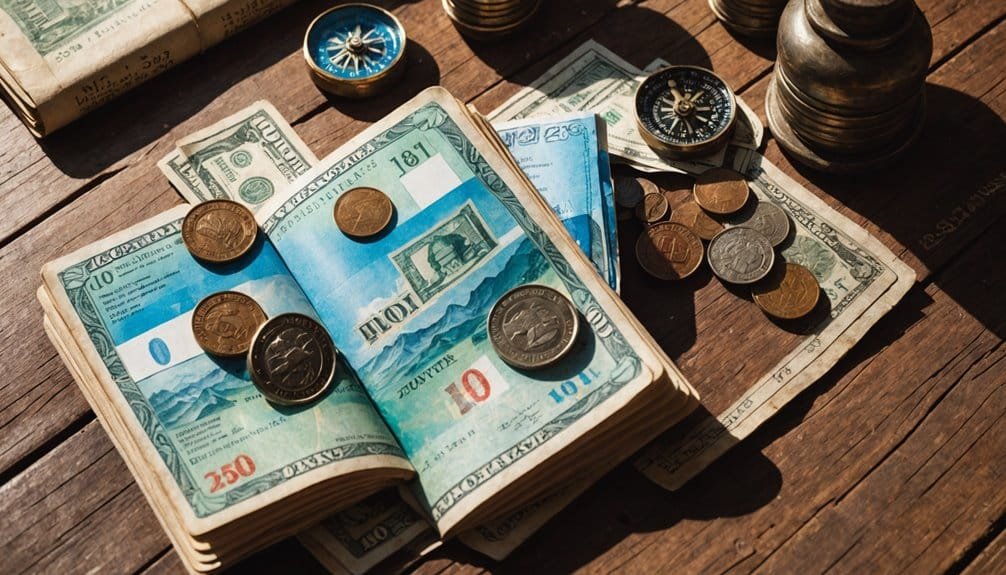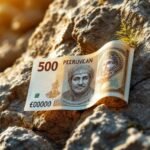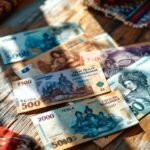
When traveling to Cusco, you'll use the Peruvian sol, a currency with deep historical roots and modern economic significance. You'll find banknotes ranging from 10 to 200 soles, featuring national heroes and stunning landscapes. Tourist-friendly shops accept both soles and US dollars, but small denominations work best in local markets. The sol's value typically hovers around 3.7 to 3.8 per USD, and exchange rates are most competitive in legal currency houses. ATMs dispense local cash, though international transaction fees apply. Stick around, and you'll uncover the fascinating monetary journey of this vibrant Andean currency.
Key Takeaways
- The Peruvian sol (PEN) is the official currency used throughout Peru, including Cusco, with denominations ranging from 10 cents to 200 soles.
- Travelers can easily exchange US dollars for soles at legal exchange houses, with current rates around 3.7-3.8 PEN per USD.
- In Cusco, both local soles and US dollars are accepted in tourist areas, but smaller towns and markets prefer local currency.
- ATMs in Cusco dispense soles and provide convenient currency access, though international transaction fees may apply to foreign bank cards.
- Banknotes feature historical Peruvian figures and landscapes, with coins showcasing national symbols like the vicuña, reflecting Peru's rich cultural heritage.
Origins of the Peruvian Currency
In the landscape of Peru's economic history, the origins of currency paint a fascinating narrative of cultural transformation.
Before Spanish arrival, Pre-Hispanic Currency was more ceremonial than economic, with indigenous communities using small copper axes, scallop shells, and coca leaves as primitive trading tools.
The Inca Empire's sophisticated quipu accounting system enabled complex trade along South America's coastal regions, though no physical coins existed.
When Spanish conquerors arrived in 1532, they revolutionized Peru's monetary system.
Colonial Coins emerged with the establishment of the Lima Mint in 1565, introducing silver *macuquinas* with irregular edges and gold *escudos* starting in 1659.
These bimetallic coins marked a significant shift from traditional indigenous economic practices, laying the groundwork for Peru's modern monetary evolution. Slave labor played a crucial role in the early coin production process, with approximately 20 workers at the Lima Mint employing enslaved individuals to support minting operations.
Understanding Sol Denominations
Every traveler and currency enthusiast will find Peru's sol denominations a fascinating study in monetary design and cultural representation.
You'll discover that banknote designs range from 10 to 200 soles, each featuring iconic historical figures like Túpac Amaru II and breathtaking landscapes that capture Peru's rich heritage.
The coins are equally compelling, with denominations spanning 10 cents to 5 soles, showcasing national symbols such as the vicuña and Nazca Lines' colibri.
Coin symbols are strategically placed, with the Peruvian Coat of Arms adorning the reverse side and two-tone metallic compositions adding visual interest.
These carefully crafted currency pieces aren't just money—they're miniature storytellers, representing Peru's cultural depth through intricate designs that transform everyday transactions into opportunities for cultural exploration.
The Central Reserve Bank of Peru meticulously designs each currency element to reflect the nation's historical and cultural significance.
Central Bank and Monetary Policy

Peru's Central Bank wields significant economic influence, expertly traversing the complex terrain of monetary policy with strategic precision. You'll find their approach to interest rates both calculated and responsive to economic indicators. In 2024, they've demonstrated flexibility by adjusting rates from 5.25% to 5.00%, always keeping inflation targets in sharp focus. Core inflation trends suggest a potential moderation in monetary tightening strategies in the coming months.
| Year | Policy Rate | Inflation Rate |
|---|---|---|
| 2024 | 5.25% | 1.78% |
| 2024 | 5.00% | 2.45% |
| 2025 | Projected | Target Range |
Their monetary policy remains restrictive yet adaptive, with analysts anticipating potential additional rate cuts. You'll notice their interventions aim to balance economic growth, control inflation, and maintain the sol's stability. By closely monitoring economic performance and global trends, the Central Bank guarantees Peru's financial landscape remains robust and resilient.
Historical Currency Transformations
The sol's journey through Peru's monetary landscape reveals a fascinating saga of economic transformation. Peru's currency has undergone remarkable changes, reflecting the nation's complex economic history. Banco de Reserva's establishment in 1922 marked a critical milestone in centralizing Peru's monetary management.
- From the peso's decimal shift in 1857 to the sol de oro's introduction
- Experiencing hyperinflation's dramatic impact in the 1980s
- Witnessing the dramatic peso evolution and inti failure
The monetary system's transformation highlights Peru's economic challenges. As silver's global value depreciated, the peso gave way to the sol de oro.
By the 1980s, hyperinflation ravaged the economy, forcing the introduction of the inti. However, the inti's instability led to its swift replacement by the nuevo sol in 1991, marking a turning point in Peru's economic stability.
This currency evolution demonstrates the country's resilience and commitment to financial reform, ultimately creating a more robust monetary framework that continues to serve Peru today.
Exchange Rates and Trade

At the crossroads of global commerce, Peru's sol navigates a dynamic landscape of international trade and fluctuating exchange rates. You'll find the sol dancing between 3.7215 and 3.8155 PEN per USD, reflecting subtle currency fluctuations that impact your financial decisions.
Peru's robust trade agreements cover 95% of its exports across 53 countries, creating a resilient economic network that supports its global market presence. The current mid-market exchange rate provides crucial insights for investors and traders monitoring Peru's economic performance.
When exploring Peru's trade ecosystem, you'll discover copper ore, gold, and petroleum driving its export strategy. China, the United States, and Japan emerge as key trade partners, contributing greatly to the country's economic momentum.
These intricate trade agreements and strategic partnerships guarantee the sol remains competitive, offering you a window into Peru's dynamic economic landscape.
Economic Impact of the Sol
You'll want to understand how Peru's Sol has been a critical tool in stabilizing the country's economic landscape through strategic currency management. The Central Reserve Bank has been instrumental in monetary system regulation, implementing comprehensive strategies to manage currency volatility and economic challenges. The Sol's journey reflects Peru's resilience in controlling hyperinflation, with targeted measures like introducing new currencies and implementing strict monetary policies that have helped maintain economic equilibrium.
Currency Stability Efforts
Emerging from the ashes of hyperinflation, Peru's Sol represents a remarkable economic transformation that stabilized the nation's financial landscape. Currency stability became the cornerstone of Peru's economic resilience, driven by strategic policy measures and institutional reforms. Historical economic challenges like the 11.1% GDP drop in 2020 further underscored the importance of maintaining monetary stability.
Key highlights of Peru's currency stability efforts include:
- Central Bank independence preventing direct government lending
- Constitutional provisions limiting fiscal deficits
- Strategic foreign exchange interventions protecting real exchange rates
The Central Reserve Bank of Peru's autonomous approach has been pivotal in maintaining market confidence.
By implementing robust economic policies, Peru successfully insulated its currency from external shocks and commodity price fluctuations.
The Sol's introduction in 1991 marked a turning point, replacing the hyperinflation-ravaged Inti and signaling a new era of economic discipline and monetary control.
Inflation Control Measures
Peru's monetary evolution didn't stop with currency stabilization—it progressed into a sophisticated inflation control strategy that would become a model for economic management. Sterilized foreign exchange interventions have been a critical tool in this approach, allowing the central bank to manage currency fluctuations while maintaining overall economic stability.
You'll find the Central Bank of Peru's approach remarkable, targeting inflation at a modest 2% with a narrow 1-3% tolerance band. This strategy goes beyond simple rate adjustments, incorporating complex tools like high reserve requirements and strategic foreign exchange interventions.
The sol's stability hinges on these nuanced inflation dynamics, which have consistently kept price increases mild.
By actively managing monetary policy, Peru has created an environment where economic predictability trumps volatility.
You'll appreciate how these measures not only control inflation but also gradually reduce financial dollarization, strengthening the domestic currency's credibility and competitive position in the international market.
Economic Recovery Strategies
Three key strategies have defined Peru's economic recovery trajectory, transforming the sol from a volatile currency to a symbol of national resilience. You'll find the nation's approach focuses on strategic economic revival:
- Implementing robust fiscal stimulus packages to jumpstart economic growth
- Introducing targeted investment incentives for private and public sectors
- Leveraging favorable mining export prices to stabilize currency valuation
Your understanding of Peru's economic recovery hinges on recognizing the multifaceted approach. The government's proactive measures include increasing public investment, supporting microenterprises, and promoting business formalization. The IDB loan program will further accelerate economic transformation by providing critical financial support and strategic development frameworks for the nation's recovery efforts.
These strategies have helped Peru rebound from the COVID-19 economic contraction, with GDP growing 13.6% in 2021 and projected 3.1% expansion in 2024. By prioritizing economic stability and creating an attractive investment environment, Peru's sol has become an illustration of the country's resilience and strategic economic planning.
Traveling With Peruvian Currency

When traveling through Peru, you'll want to master the art of cash exchange and smart spending with the local currency, the nuevo sol. Understanding how to obtain, use, and protect your money can transform your travel experience from stressful to seamless, ensuring you're prepared for everything from street market purchases to high-end restaurant transactions. Currency regulations make it crucial to familiarize yourself with local monetary practices to avoid potential financial pitfalls during your journey.
Cash Exchange Essentials
Maneuvering Peru's currency landscape requires savvy travelers to understand the nuanced world of cash exchange and local monetary practices.
- Exchange rates fluctuate between 0.2621 and 0.2697 USD per PEN
- ATMs dispense local currency with potential international fees
- Tourist areas welcome both US dollars and Peruvian soles
When planning your currency exchange, prioritize legal exchange houses for competitive transaction tips. Always compare rates at banks, hotels, and authorized money changers to maximize your purchasing power. Currency conversion alerts allow travelers to track favorable exchange rates in real-time, ensuring optimal financial strategy during their Peruvian journey.
Cash remains king in smaller towns and markets, so carry small denominations of soles for seamless transactions. Be vigilant about counterfeit risks and verify bill authenticity before completing exchanges.
Credit cards work well in larger cities, but don't rely on them exclusively. Understanding the current exchange rate—roughly 3.72 PEN per USD—will help you budget effectively and avoid unexpected financial surprises during your Peruvian adventure.
Money-Saving Travel Tips
Smart travelers know that mastering money-saving strategies can transform a Peruvian adventure from budget-breaking to budget-brilliant.
Embrace cultural immersion by choosing local transportation like buses and colectivos, which offer scenic routes and significant savings compared to flights. Street food becomes your wallet's best friend, providing delicious, affordable meals that connect you directly with local culinary traditions.
Budget travel in Peru means thinking creatively about accommodations. Consider Couchsurfing for free stays, or book hostels during shoulder seasons when prices drop.
Traveling with friends allows you to split expenses, making your soles stretch further. Use local ATMs wisely, preferring Scotiabank to minimize fees, and always carry small denominations of both Peruvian currency and US dollars. Water purification methods can also help you save money, reducing the need to constantly purchase bottled water during your travels.
Conclusion
Understanding the Peruvian sol is like steering through a complex tapestry of economic history. You'll find that this currency isn't just money, but a reflection of Peru's resilient economic journey. Whether you're a traveler or economic enthusiast, appreciating the sol's nuances can reveal deeper insights into Cusco's financial landscape. It's more than paper and coins—it's a story of cultural and economic transformation waiting to be explored.







Interesting read! Wondering though, how does the Central Banks policy influence the value of Sol in the international market?
Interesting read, but wouldnt it be more helpful to include a comparison of Sol to other global currencies? Just a thought.